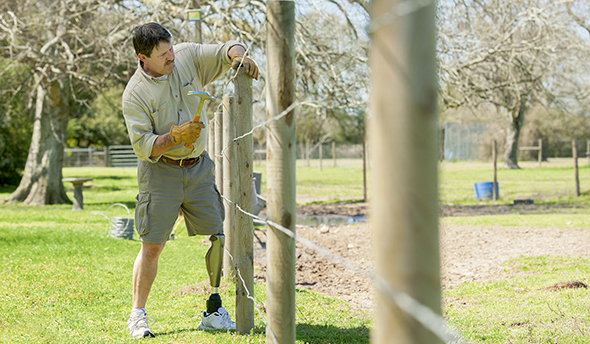Which suspension system is right for you?
Suspension refers to the way in which your prosthesis is connected to your residual limb. As we explained in our last article about suspension, there are three types of suspension systems: vacuum, shuttle lock and suction. With a vacuum system, the air between the socket and liner is extracted by a pump and valve, creating a vacuum that keeps the socket in place. With a shuttle lock system, a liner with a pin is secured inside the socket. Finally, a suction system ensures that the excess air between the liner and socket is removed through a valve when weight is put on the prosthesis. Now to the practical aspects! Which suspension system is best for you?
How do you choose a suspension system?
Your meetings with your O&P professional form the basis for choosing a prosthetic system. So, make sure that your O&P professional understands exactly what your goals are and the challenges you face. We recommend reading up about the different options as much as possible. The more you know about suspension, the easier it will be to discuss the topic with your O&P professional. Your suspension system is extremely important for comfortable and safe walking, so it is essential that you work together closely with your O&P professional and get the suspension system that meets your specific needs. We’ve put together a list of factors that are important to consider when choosing a suspension system.
Activity level
Are you young, mobile and athletic? Or are you older and spend most of your time at home? Your activity level is very important when choosing a suspension system. A shuttle lock system is the best choice for older people and those with reduced mobility, while a suction system can be used for all activity levels. Vacuum systems, on the other hand, are primarily suitable for those who are quite active.

Comfort
Both the vacuum and suction system require a socket that covers the entire surface of your residual limb. The reason is that it distributes the pressure evenly across the residual limb. This pressure reduction means that both of these suspension systems are very comfortable. Since a vacuum system minimises the movement of the residual limb in the socket, this system is the most comfortable one. The second most comfortable option is the suction system. A shuttle lock system offers the least amount of control and results in the most amount of movement and friction in the socket.
Performance
A vacuum system offers the best performance for maximum confidence in and optimal control of the prosthesis. This helps in developing a smooth and symmetrical gait that requires less energy. Shuttle lock systems meet the needs of users with a low activity level. But users who are more active will probably experience that a shuttle lock system offers less control and safety.
Health of the residual limb
When it comes to this factor, the vacuum system is also an excellent choice. A vacuum system increases hydration and blood flow, so that open wounds can heal – even while wearing the prosthesis. It also helps regulate volume changes in the leg. After all, tissue shrinks and swells during the day. With the vacuum system, the user’s limb maintains the same shape and size all day long. This in turn helps ensure a good fit.
Other suspension systems make blood vessels narrower, resulting in a reduction of around 10 to 14 percent of leg volume throughout the day. A prosthesis that fits well in the morning will start feeling looser later in the day as a result. Too much movement in the socket can cause pain and blisters. It can also result in significant forces being placed on your residual limb because the socket slides every time you lift your leg to take a step and then puts pressure on your residual limb when you put weight back on your foot. Read about how to care for your residual limb properly following amputation.
Convenience
Shuttle lock systems are the easiest to put on and off. But, with this type of system, you sometimes have to put on and remove your prosthetic sock three or four times a day in order to compensate for a difference in leg volume. With a vacuum or suction system, your daily routine is as follows: you put on your liner and a shorter prosthetic sock, slide into the socket, rub lotion on your leg to prevent the skin from pulling and, finally, roll up the sleeve to seal the liner. Since it is not necessary to change the fit over the course of the day, an active vacuum system can save time. Most people who use a vacuum system say that the morning routine does not outweigh the advantages throughout the day.